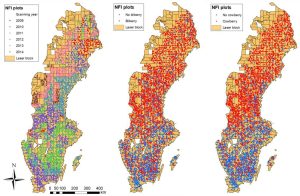
Distribution of NFI plots used for modelling by scanning year (left) as well as by bilberry (middle) and cowberry (right) occurrence on laser blocks. (Credit: Forest Ecology and Management)
By combining nationwide airborne laser-scanning data and data on berries collected in connection with forest inventories, it's possible to make small-scale berry-yield predictions for an entire country. These predictions indicate potential berry-picking locations, but do not accurately predict berry yields.
The models published are the world's first berry-yield predictions directly based on airborne laser-scanning data. The study examined the prediction of bilberry and cowberry yields in Sweden.
In the Nordic countries, forest berries are among the most-exploited non-wood forest products, with cowberry and bilberry having the highest commercial value. These berries have very different requirements for growing conditions. In the Nordic countries, berry picking comes under the right of public access, which makes it possible for everyone to pick berries for their own consumption as well as for sale. Berry picking is also an important recreational hobby, and berries are regarded as super food with plenty of positive health effects. In berry picking, knowledge of good locations is key. In this study, this knowledge was generated through remote sensing.
Published in Forest Ecology and Management, the study was conducted in collaboration between the Swedish University of Agricultural Sciences, the University of Eastern Finland, and Natural Resources Institute Finland.

